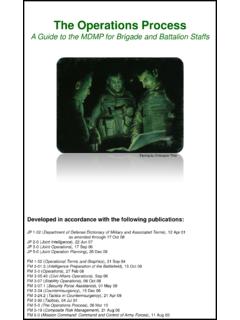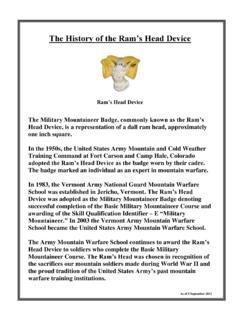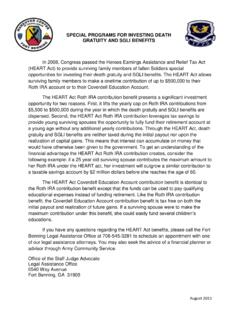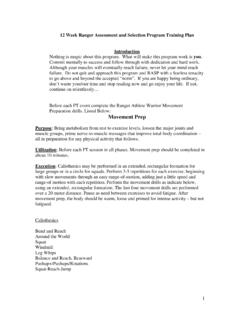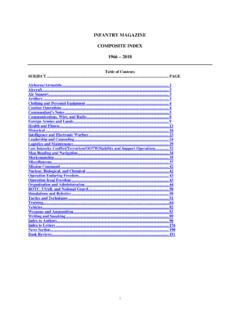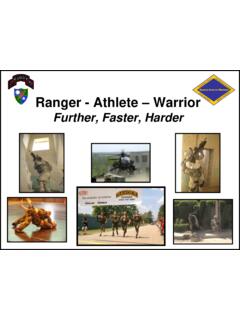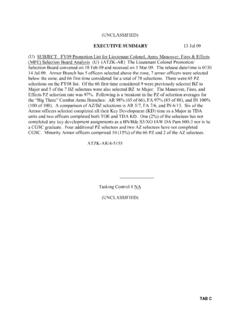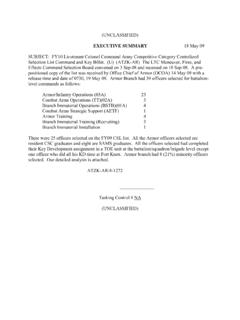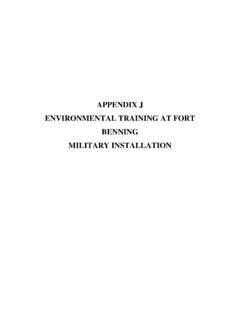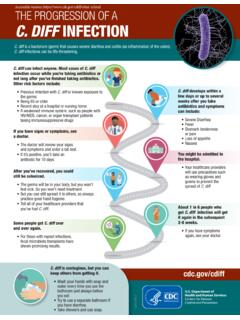Transcription of Infantry (CMF 11) Career Progression Plan Chapter 1. Duties
1 Infantry (CMF 11) Career Progression Plan Chapter 1. Duties The Infantry is a unique branch, designed to close with the enemy by fire and maneuver, to destroy or capture them, and to repel their assault by fire, close combat, and counterattack. The Infantry is the only branch in the Army organized, equipped, and trained to accomplish this mission. Infantry leaders synchronize all elements of combat power to defeat the enemy. Infantry NCOs ensure Soldiers under their supervision receive individual training in their MOSs and basic Soldier skills. Infantry NCOs also train Soldiers to fight, win, and survive on the battlefield. NCOs are prepared to train, lead, and employ Infantry and other combat arms assets on the battlefield, across the full spectrum of military operations. The Infantry arrives on the battlefield by parachute or air assault, mechanized or wheeled vehicle, or on foot.
2 Insertion means are dependent on the mission, enemy, terrain, weather, and time available. CMF 11 is comprised of three separate and distinct Military Occupational Specialties (MOS), MOS 11B Infantryman, MOS 11C Indirect Fire Infantryman, and MOS 11Z Infantry Senior Sergeant. Chapter 2. Transformation Infantry units and organizations transform in terms of design and equipment to adapt to changes in the operational environmental, adversarial capabilities, doctrine, and technology. Infantry Soldiers assigned to vehicular or non-vehicular, generating or operating force organizations, are all linked through the core CMF 11 competencies to one common mission: To close with and destroy the enemy through ground combat. Infantry Soldiers and NCOs must be adaptable and resilient, to rapidly respond to transformation and master the unique characteristics of each type of Infantry formation.
3 Regardless of formation design, the building blocks of the Rifle Squad and Platoon and the key tactics, techniques, and procedures associated with each remain constant. Above all else, the culture of the Infantry requires its Soldiers to be mentally and physically strong and disciplined. The Infantry culture is the basis for the Army s warrior ethos and is rooted in the harsh realities of the battlefield, which, for the Infantry Soldier, is close, personal, and brutal. Chapter 3. Recommended Career management self-development, by rank a. Private E 1 (PVT): specialist (SPC)/corporal (CPL). The proponent recommends the following for self-development: (1) Infantry Soldiers should seek self-development through reading materials listed in TC 7 , the Chief of Infantry s Reading list, as well as publications related to the operation, employment, and maintenance of squad/section weapons and equipment.
4 (2) Volunteer and prepare themselves for appearance at Soldier boards, such as for Soldier of the Quarter and Soldier of the Year . These events will broaden the Infantry Soldiers knowledge base, instill discipline, and improve their ability to communicate verbally. (3) All PV1 through SPC/CPLs should strive to earn the Expert Infantryman Badge (EIB). (4) Infantry Soldiers should seek to attend the Basic Leaders Course and complete SSD Level I at these ranks. Obtaining recognition as the Honor Graduate, Distinguished Honor Graduate or Commandant s List at the Basic Leaders or any course attended should be the goal of all Infantry Soldiers. (5) Soldiers with general technical (GT) scores below 100 should seek to improve their scores through FAST, not only for self-improvement but to improve their options for reenlistment and to meet future functional or special skills course prerequisites.
5 (6) All Infantry Soldiers should take the opportunities provided by the Army through programs such as CLEP, DANTES, and GoArmyEd to increase their individual level of civilian education now and throughout all ranks. There is no requirement for enlisted personnel to earn a college degree; however, Soldiers employ and operate extremely complex technical equipment, in order to engage and destroy the enemy, while operating in a full spectrum environment. Based on this requirement, it is highly encouraged for all Soldiers to pursue college education to better prepare them for the modern battlefield environment, which requires an educated force. b. Sergeant (SGT). (1) SGTs should study and master the publications mentioned in skill level 1 as well as the following military publications: STP 21 24 SMCT, FM 6 22, FM 21 18, FM 3 , all -10 level maintenance manuals associated with their equipment, and battle drills associated with their current assignment.
6 (2) TC 7 contains suggested reading for SGTs. Many units as well as the SMA have suggested reading lists for Soldiers seeking self-development. (3) NCO boards such as NCO of the Quarter, Soldier of the Year, and organizations such as the SGT Audie Murphy and SGT Morales Clubs broaden the knowledge base, instill discipline, and improve communication skills and leadership potential. (4) All SGTs should strive to earn the EIB, volunteer to attend and successfully complete the Ranger Course, and complete SSD Level II. (5) SGTs should continue to focus on their individual level of civilian education. (6) Obtaining recognition as the Honor Graduate, Distinguished Honor Graduate or Commandant s List at the Advanced Leaders or any course attended should be the goal of all Infantry SGTs. c. Staff sergeant (SSG). (1) SSGs should study and master the military publications mentioned in skill levels 1 and 2 as well as: AR 623 3; STP 21 24 SMCT; FM 3 ; FM 3 ; and all -10 level maintenance manuals associated with their equipment; and battle drills associated with their current assignment.
7 (2) SSGs should continue to seek out suggested reading lists from mentors, commanders, and senior leaders. (3) NCO boards such as NCO of the Quarter, Soldier of the Year, and organizations such as the SGT Audie Murphy and SGT Morales Clubs broaden the knowledge base, instill discipline, and improve communication skills and leadership potential. (4) All SSGs should strive to earn the EIB, volunteer to attend and successfully complete the Ranger Course, Bradley Fighting Vehicle Master Gunner Course, and/or the Battle Staff NCO Course, and complete SSD Level III. (5) SSGs should continue to focus on their individual level of civilian education. (6) Obtaining recognition as the Honor Graduate, Distinguished Honor Graduate or Commandant s List at the Maneuver Senior Leader or any course attended should be the goal of all Infantry SSGs. d. Sergeant first class (SFC).
8 (1) As NCOs become more senior in rank, self-development becomes more important. Activities such as professional reading help the Senior Infantry NCO develop organizational leadership skills needed to coach, teach, and mentor Soldiers. Publications such as AR 350 1, FM 1 02, AR 750 1, -10 level maintenance manuals associated with their equipment, and battle drills associated with their current assignment are all important focuses of self-development. (2) A SFC must continue to remain competent in technical fields while focusing on broadening management and doctrinal knowledge. Subjects such as organizational behavior, personnel management, time management, Army operations, and battle staff functions are essential at this rank. (3) SFCs should have earned a minimum of 30 semester hours of college or post-secondary civilian education. College courses are not required for promotion, but can be a deciding factor when it comes to recognizing those that are most or highly qualified for advancement.
9 (4) All SFCs should strive to earn the EIB, volunteer to attend and successfully complete the Ranger Course, Bradley Fighting Vehicle Master Gunner Course, and/or the Battle Staff NCO Course, and complete SSD Level IV. e. Master sergeant (MSG)/first sergeant (1SG). (1) In addition to those publications and reading lists mentioned in the ranks above, MSGs/1 SGs should also study and master the following military publications: AR 601 280, AR 600 20, DA Pam 611 21, AR 840 10, and AR 220 1. (2) MSGs/1 SGs should have earned a minimum of 60 semester hours of college or post-secondary civilian education. College courses are not required for promotion, however limited authorizations and fiercely competitive records may dictate civilian education be considered a major discriminator for selection to SGM. (3) All MSG/1SG should strive to earn the EIB and complete SSD Level V.
10 F. Sergeant major (SGM)/command sergeant major (CSM). (1) SGMs/CSMs should read publications on the professional reading lists of their chains of command and senior leaders. (2) SGMs/CSMs should have earned a minimum of 90 semester hours of college or post-secondary civilian education. (3) All SGMs/CSMs should strive to earn the EIB and complete SSD Level VI. Chapter 4. Military Occupational Specialty 11B (Infantryman). a. Major Duties . The Infantryman serves, leads, or supervises as a member of an Infantry organization that employs individual small arms weapons or heavy anti-armor crew-served weapons, either mounted or dismounted, in support of offensive and defensive combat operations. Commanders and CSMs ensure Soldiers are serving in appropriate developmental, broadening, and special assignments and know how these assignments affect promotion and Career development.
